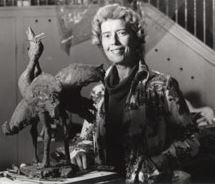Helen Schou facts for kids
Helen Schou (born April 19, 1905 – died March 27, 2006) was a famous Danish artist. She was best known for making amazing sculptures of horses. Her two most famous works are the statue of King Christian IX on his horse in Aarhus Cathedral and the large Jutland Stallion in Randers. She was honored with a special award, the Order of the Dannebrog, for her contributions.
Contents
Early Life
Growing Up and Discovering Art
Helen Rée was born on April 19, 1905, in Frederiksberg, Denmark. Her father, Ivar Müller Rée, was a stockbroker. This means he helped people buy and sell shares in companies. From a young age, Helen knew she wanted to be an artist. At first, she enjoyed drawing and painting.
Helen was also a very keen horse rider. She loved horses so much that she competed in events and even raised her own horses. Her parents, who lived in Copenhagen and were quite well-off, supported her dreams. However, her father was a bit worried when she decided to sculpt instead of paint.
Learning to Sculpt
When Helen was 18, she started studying with a well-known sculptor named Anne Marie Carl-Nielsen. At that time, Carl-Nielsen was working on a big statue of King Christian IX on a horse. This gave Helen a great chance to learn how to create large monuments.
In 1926, Helen married Holger Høiriis Schou. He was the director of a big soap company. By the end of 1927, Helen finished her studies with Carl-Nielsen. She then showed her work for the first time at the Charlottenborg Spring Exhibition. In 1929, she joined the Royal Danish Academy of Fine Arts. There, she learned from another famous sculptor, Einar Utzon-Frank.
In 1932, Helen left the Academy to continue her studies abroad. She traveled to places like Florence, Paris, and Rome. To really understand horses, she even took special classes. These classes taught her about horse anatomy by studying their bodies closely.
Career
Creating Amazing Sculptures
From the late 1920s, Helen Schou started getting many requests for her art. Sometimes, she faced challenges because she was a woman. Some people thought women couldn't handle big projects. Others felt she didn't need the work because of her family's status.
She showed her art at the famous Salon in Paris from 1929 to 1934. She also took part in the Spring Exhibition every year until the 1950s. While she is most famous for her horse statues, Helen also loved sculpting people. She made many portraits of artists, ballet masters, and actors. These were often made of bronze or marble.
Some of her well-known sculptures include:
- Hest overfaldes af Slange (Horse Attacked by Snake, 1935) in Randers.
- Styrtende Amazone (Stirring Amazone, 1938) which is in a museum in Oslo.
- Morgengry (1939) for a park near Lyngby Lake.
- Hest med føl (Horse with foal, 1940) which is now in Øregård Park in Hellerup.
- A sculpture of her husband, Holger Høiriis Schou (1941).
- Moder med Barn (Mother with Child, 1943) at the park of Bellevue Beach.
Her Masterpieces
Helen Schou's two most important works are the statue of King Christian IX and the Jutland Stallion. She spent twelve years working on the riding statue for Aarhus. She started in 1944. Her goal was to create a city landmark that showed both movement and stillness. It also had to give equal importance to both the horse and the rider. This impressive statue was placed in front of the Aarhus Cathedral in 1955.
The Jutland Stallion is a huge sculpture. It stands five meters (about 16 feet) tall and is six meters (about 20 feet) long. It shows a powerful Jutland workhorse. Helen made sure to show its strength and energy through the clear shapes of its muscles. The city of Randers asked her to create this in 1959, and it was put in place ten years later.
In the 1970s, Helen visited Uganda. This trip inspired her to create sculptures about mating rituals for a treatment center in Charlottenlund. This work was installed in 1988.
Recognition and Awards
Helen Schou was an active member of the art community. She served on the board of the Danish Sculpture Society from 1937 to 1938 and again from 1941 to 1942. In 1956, she received the Agnes Lunn Prize. She was also a member of the Royal Danish Academy of Fine Arts from 1959 to 1978. She even led the committees for sculptors between 1967 and 1968.
In 1965, Helen was honored as a Knight of the Order of the Dannebrog. This is a very special award in Denmark. She was then promoted to a Knight 1st Class in 1974. As art styles changed in the 1960s and 1970s, Helen's realistic style was sometimes less appreciated. However, in 1995, a special exhibition of her works was held by the Den Frie Udstilling, celebrating her art.
Death and Legacy
Helen Schou passed away on March 27, 2006, at her home in Holmegårdsparken, Charlottenlund, Denmark. She had three children: Eva (born 1927), Dorrit (born 1937), and Christian (born 1940). Besides her public monuments, her works can be found in places like the Rigshospitalet and the Theatre Museum in the Court Theatre.
Images for kids



